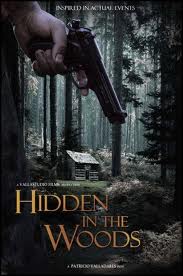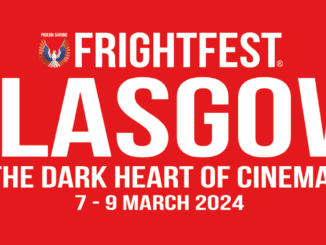Azrael: Angel of Death, Invader, Never Have I Ever, Saint Clare
 Day four is upon us! And after a solid Saturday, can it keep up the standard? I have four movies to watch today at Pigeon Shrine FrightFest – I would have done the full five, but we’re beside one of the UK’s jazz hubs, and I fancied a quartet (get along to The Spice of Life in Soho folks). Besides, sometimes you need time to break before going into the thick of the action. Which brings me to…
Day four is upon us! And after a solid Saturday, can it keep up the standard? I have four movies to watch today at Pigeon Shrine FrightFest – I would have done the full five, but we’re beside one of the UK’s jazz hubs, and I fancied a quartet (get along to The Spice of Life in Soho folks). Besides, sometimes you need time to break before going into the thick of the action. Which brings me to…

AZRAEL: ANGEL OF DEATH
Directed by E.L. Katz
An end of the world epic on a budget. Many years after the apocalypse, a pack of religious zealots hunt down a young woman, Azrael, intending to sacrifice her to appease an ancient evil. We don’t get to know the nature of this evil, but it appears to have returned the dead to life. However, this is a Samara Weaving film, and she’s not going to take it lying down. What follows is a visceral, grizzly, back-to-basics action penned by Simon Barrett of You’re Next and Blair Witch fame. Playing out mostly in real-time, Azrael gives generous amounts of blood, guts, and mindless zombie mayhem for your buck. The pace rarely lets up long enough to give its protagonist or the audience a chance to breathe. Thankfully, Weaving more than matches the materials’ demands, offering an intense physical performance that’s easily among her most impressive work to date. And all without saying a word! As explained in the intro, speech has been outlawed (for reasons we never learn), so all the hunters are mute save for the odd grunt, growl and call. Still, the focus on action over or dialogue means that we don’t get a feel for her character, the wider mythos, or what the world looks like beyond the endless trees. This won’t be a problem for some viewers – a good image speaks a thousand words. Yet the lack of explanation meant I wasn’t invested in any of the events – even if I was impressed by their presentation. The action is impressive for a film with a fraction of the budget of most blockbusters, with some accomplished fight scenes and chase sequences. However, they are mostly small-scale and utilize the same repetitive woodland surroundings – there is no escalation, only more fighting, til the finale ups the ante. Still, it would have been good to see more of the encampment or the religion, which could have also given it a more unique identity. In that respect, the best and worst thing about it is the silence.

NEVER HAVE I EVER
Directed by Damon Rickard
One of the rewarding things about attending FrightFest is seeing the same faces – people you recognise or come to know in person or across social media. I have likely exchanged two sentences with Rickard, yet I see him among the crowd every time. He’s also worked on several of the funny ‘turn off your bloody phone’ adverts that play before screenings. As such, it’s good to see his surprisingly dramatic feature debut premiere here. It’s a small-scale revenge thriller about two deeply damaged individuals, Sam and Mara, and the tragedies that connect them. We open on Sam having a bad day – his bank card is gone, he’s missed a deadline, and somebody’s been in his house (a plot point that gets treated with frustratingly little urgency). So he does what any man with a drinking problem would do and head out for a pint. Alas, the barman isn’t letting him wet his beak for free, but thankfully, a seemingly good Samaritan, Mara, offers to get him a round. Their conversation is tempestuous, with him pushing all her buttons for sport, but rewarding enough for both that they choose to meet again – since Sam’s social drinking became more frequent and less social, one gets the impression he’s not used to people reaching out full stop. Then Mara suggests they play the titular drinking game… If this film has a key problem, it’s the pacing. The first half passes slowly, even dragging in places until Sam and Mara start talking to each other. As with how each appears to need that connection, so does the audience. Rickard has a good ear for dialogue and clearly knows both parts well – I suspect they lived in his head for a while. There’s a game element being played beneath the surface as each susses the other out, and while their exchanges sometimes verge on being too on the nose, the tension steadily grows to a devastating climax. Andrew Lee Potts is outstanding as Sam, capturing his drive for self-destruction and in-your-face charm. He’s an engaging protagonist with many, many flaws yet the way he battles on through a series of mishaps creates enough goodwill before we move on to the more challenging material. The choice to make him a screenwriter – an industry few people fall into – gives the impression of someone who used to be a more sensitive and driven man before alcoholism kicked in. We learn less about Mara today, though Beatrice Fletcher finds an emotional reality behind what could have been a melodramatic part. The synth score, by fellow FrightFest regular Mitch Bain, also adds to the atmosphere immensely – supplying the action with a heartbeat action that compliments the onscreen action rather than telling the viewers what to think. This is important as the gradual unfolding of what connects them is a morally grey look at how a few terrible decisions, and lapses in judgment, can have massive consequences. On that, while it is hard to imagine this getting a mainstream release, I hope it provides a stepping stone into bigger things for Rickard and co.

SAINT CLARE
Directed by Mitzi Peirone
Troubled teen time! At face value, Clare Bleecker is a normal, if unusually sweet-natured, college student. Yet she lives a secondary life as a serial killer spurned on by voices in her head that ask her to assassinate deserving people – it’s what Joan of Arc would have done. However, this campaign for vigilante justice soon leads her deeper into a seedy underworld of human trafficking and moral decay. This may sound like a devout dexter, and there are elements of that, down to the imaginary mentor figure who acts as a mentor (before vanishing for over half the movie). But this is spliced with small-town paranoia, noir thriller, and rape revenge. Unfortunately, these elements don’t combine well and make for a narrative that feels both cluttered and empty, with a convoluted conspiracy that also lacks depth or complexity. I don’t usually like to comment on the acting, though it sometimes felt like I was watching a rehearsal. However, having seen some of the cast deliver in other projects, I think the main problem is the Lifetime-style script and production values that do them a disservice. Ryan Phillippe briefly shines as as Detective Rich Timmons, even if he seems to be doing his best Horatio Caine impression, but as an antagonist I just didn’t buy that he’d be that suspicious of Clare – however, for a sociopath who is used to acting, she does a remarkably poor job of playing it cool. Still, plaudits to her for coming up with one of the weirdest ways of evading him – getting a part in a play with the only other people who seem to go to this college. The baddies, who introduced really late on, are afforded little to no psychological depth or motivation beyond being there to get taken out in a smattering of John Wick style moments (in the film’s most interesting scene, we learn Clare was taught to be fight by her actor granny). The hollow writing detracts from any moral ambiguity implied by the premise, simplifying potentially stimulating questions about salvation and restorative justice. I would have liked to see the titular character be both saint and sinner, though when confronted with the rogue’s gallery of men she meets, any such nuance is lost since, in the sensationalist universe this movie establishes, they deserve to die. Moreover, the sense of a religious quest is alluded to through the use of Christian iconography and a repeated prayer, but its very surface-level and maybe a greater attempt to interrogate/personalise this could have strengthened it as a perspective piece and ironised the simplified world presented here. There’s really no subtext to this movie and the allusions to Joan of Arc are almost comically direct. The dialogue is similarly blunt throughout, with functional exchanges leaving little room for complex dynamics or subtle power plays. Characters and their relationships are written with thick, broad strokes, and what we’re supposed to feel gets underlined by a leading soundtrack. None of this would necessarily be game over if the storytelling were better, but it’s a mystery with very few mystery elements. And don’t get me started on the very end that seems more done for shock than because it feels like a logic next step. I suspect I’ll be massively in the minority here, as twitter implies a lot of people loved it. Though after twelve years of coming, this is probably among the worst film I’ve ever seen at FrightFest.

INVADER
Directed by Mickey Keating
That’s more like it! The opening of Invader is just brilliant – a symphony of destruction as a man with a sledgehammer utterly destroys a beautiful suburban home and everything in it. There’s such aggression and energy to it that it’s almost difficult to watch. This invader isn’t just a presence but a force – stomping around in heavy boots, dragging a noisy sledgehammer with him. It’s less invasion than pure violation. What follows is a small-scale suburban horror about a young woman, Ana, who is worried something has happened to her cousin, so she takes the late-night bus to find her. Guess where she lives. Invader is a creepy movie that gets under the skin early on and refuses to leave. Keating does a great job of finding sources of uneasiness in normality – the America Ana traverses is one of the broken buildings, faded flags, broken cars, and late-night trains to anywhere else. Vero Maynez plays her with a streetwise strength coupled with an understandable vulnerability – she’s at her best in the early morning scenes where every noise is a threat. The handheld camera work authenticates the proceedings, giving a nervous energy that the story builds upon. However, towards the end, it becomes a character unto itself, leaving Ana’s side to peer around corners and upstairs. The last act is pure tension, and while Keating uses one of my least favourite tropes to characterise the villain their brute force more than made up for it. Without specifics, the last five minutes are unconventional but among the most tense I’ve seen at the festival this year. It’s a concise film – barely even a feature. Yet the austere approach also makes it leaner, with less time for the audience to feel at ease. That being said, as much, less isn’t always more and the lack of characterisation meant that I couldn’t really empathise with Ana. Still, it’s hard not to be invested in her safety when you’re in what remains of that house – the worst-case scenario is you’re made to stay in that mess for longer.








Be the first to comment